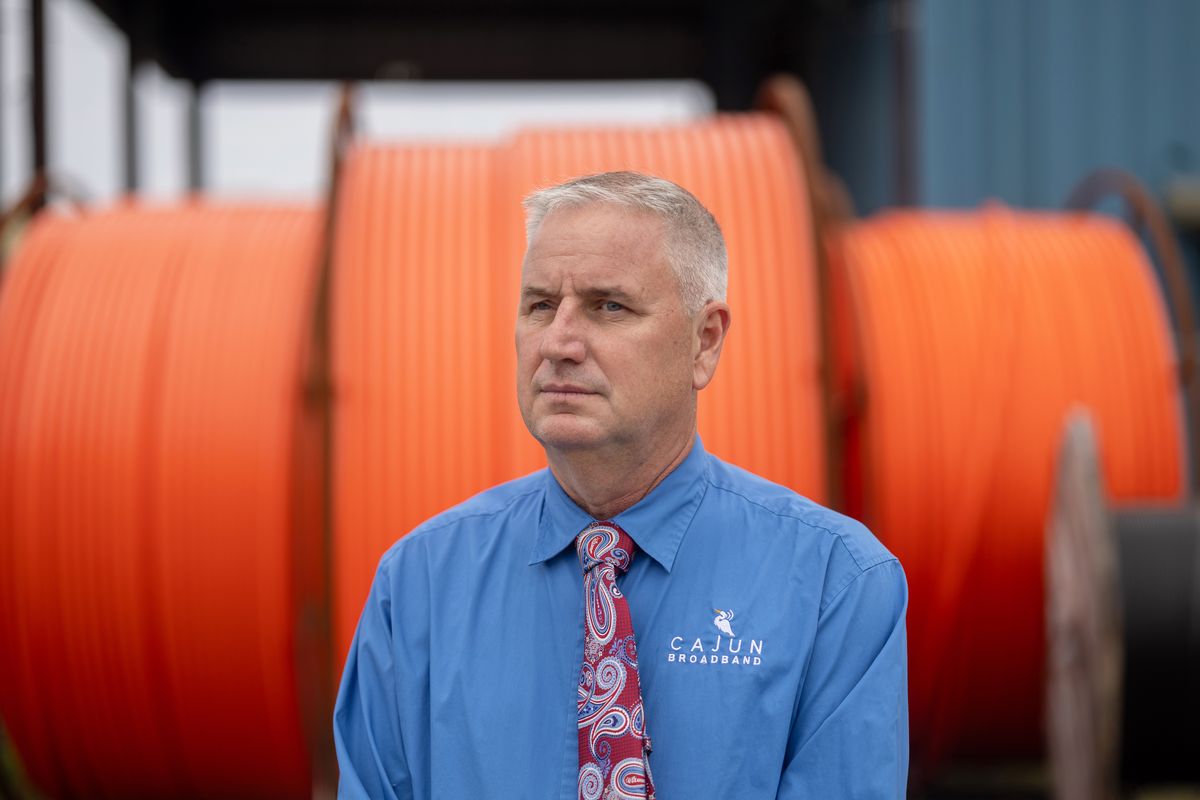Rural internet program on hold as Musk’s satellites get new consideration
Chris Disher is the co-owner of Cajun Broadband, a Louisiana business awarded $33 million under a Biden-era plan to bring internet to rural parts of the state. MUST CREDIT: Kathleen Flynn/For The Washington Post (Kathleen Flynn/For the Washington Post)
Chris Disher, the co-owner of a rural internet provider in Louisiana, is ready to start digging to get fast and reliable internet to some of the estimated 450,000 households and small businesses in the state that don’t have it.
His company, Cajun Broadband, was awarded $33 million in January under a Biden administration plan to do just that. But the money isn’t flowing while the Trump administration revamps the program and opens it up more to satellite internet, including Elon Musk’s Starlink.
Now Disher is worried that a long-promised push for rural access will be upended, leaving Louisianans desperate for internet waiting.
“I really hope they don’t start over again because it’s a lot of work there that’s gone into that,” Disher said. More than losing up-front business costs, he added, “the bigger impact for me is not going to help people.”
Other recipients of Broadband Equity Access and Deployment grants have also expressed worries that years of planning to bring internet to underserved rural households could be stymied by the Trump administration’s shift in the program’s direction. Under the original plan, which Congress approved with bipartisan support in 2021, Louisiana was set to receive $1.4 billion as part of the $42 billion program.
Commerce Secretary Howard Lutnick announced in March that the program would drop former president Joe Biden’s “woke mandates” and “burdensome” regulations, and take a “tech-neutral” approach to getting internet to rural residents. “Under the revamped BEAD program, all Americans will receive the benefit of the bargain that Congress intended,” Lutnick said on March 5. “We’re going to deliver high-speed internet access, and we will do it efficiently and effectively at the lowest cost to taxpayers.”
The program has been designed overwhelmingly around installing underground fiber-optic cables, a medium widely seen as a gold standard for fast and reliable internet. Some critics of the BEAD program say that approach is too expensive and time-consuming, and that using the “low-orbit satellite” technology offered by Starlink and Amazon’s Kuiper costs less and can get people connected faster. (Amazon founder Jeff Bezos owns The Washington Post.)
Comparing costs is not a simple matter, though. While satellite internet is cheaper to set up initially and works well for remote areas, the technology would cost households far more in the long run, said Drew Garner, director of policy engagement at the Benton Institute for Broadband and Society, an Illinois-based nonprofit. Starlink rates run about $120 a month, according to its website. The average fiber plan costs around $80, though prices vary broadly with speed.
Many BEAD participants welcome some of the changes – such as tossing environmental and labor requirements – but say further delays would cause costly setbacks. And any shift to having states cover more rural areas with satellite internet, such as Starlink, could saddle households with inferior service and higher costs in the long run, some providers said.
“My concern is we have a generational change that we could make throughout that rural country right now,” said Disher, who co-founded Cajun Broadband in 2017, adding that he didn’t want authorities “to settle on a lesser-tier technology that may be outdated in the future, instead of using your money wisely.”
Three states – Louisiana, Nevada and Delaware – have finalized their plans under BEAD, so any pivot could disrupt their efforts, said Evan Feinman, who ran the BEAD program before resigning from the National Telecommunications and Information Administration (NTIA) in March.
“It could force all the states to rerun processes,” he said in an interview, meaning “millions of private capital is in the garbage.”
Though Lutnick did not explicitly mention a preference for satellite services in his announcement, Feinman said the commerce secretary “unambiguously” instructed his colleagues in February to increase satellites and decrease fiber in the BEAD program.
“We could have shovels in the ground in three states and have half the states by this summer if the new administration focused on the things they want to change,” Feinman said. The Trump administration could lose the equity requirements the Biden administration inserted in the plans for political reasons, let the process continue and “take the win,” he added.
It isn’t taking that path, he suggested in a March 14 resignation letter to his colleagues, is that it wants to favor satellites – and Musk.
“Stranding all or part of rural America with worse internet so that we can make the world’s richest man even richer is yet another in a long line of betrayals by Washington,” Feinman wrote.
The National Telecommunications and Information Administration disputed Feinman’s characterization of Lutnick’s instructions to staff, saying the secretary told staff to remove unnecessary mandates, save taxpayer dollars and eliminate favoritism toward any particular technology.
“NTIA is revamping the BEAD program to take a tech-neutral approach, removing the prior Administration’s favoritism toward certain technologies as well as its burdensome mandates and regulations,” said an NTIA spokesperson, speaking on the condition of anonymity under ground rules set by the agency. “After years of delay, we are working quickly to get this program moving and finally deliver high-speed internet access to Americans, at the lowest cost to taxpayers.”
As the completed state plans currently stand, the vast majority of internet infrastructure in Louisiana, Nevada and Delaware will be delivered via fiber-optic cable networks, typically installed underground. But the program provides that states can deliver internet through other means in areas where cables are too difficult or expensive to install. That includes fixed-wireless, in which a radio tower beams internet into a household receiver, and low-orbit satellite, which requires households to set up a dish that can receive signals from satellites.
Starlink, which is run by Musk’s SpaceX, dominates the satellite internet business, with more than 7,000 satellites orbiting Earth as of February. Its closest competitor, Amazon Kuiper, is scheduled to launch a first tranche of its planned 3,000-plus satellites into orbit in the coming months. Kuiper won a $14 million grant under the BEAD program to provide services to nearly 5,000 locations in rural Nevada.
Possible changes to the program, such as removing the BEAD program’s preference for fiber-optic cables, “would be a way to drive a whole bunch of money to Musk or Bezos,” Garner said.
Still, several state broadband offices said they backed the changes.
“The Delaware Broadband Office supports policymakers seeking to streamline the BEAD planning process but is mindful of the potential for unintended delays,” said Christina M. Dirksen, strategic communications manager at the state’s Department of Technology and Information.
Veneeth Iyengar, executive director of ConnectLA, the state government body that administers the federal grant money to Louisiana, likewise said “companies are ready to go” in his state.
Small businesses set to the work, meanwhile, are most anxious about costly delays.
“We are ready to put shovels in the ground,” said Claude Aiken, chief strategy officer at internet provider Nextlink, which received $5.3 million to bring fixed-wireless service to over 2,400 households and businesses in Louisiana. “If changes are made that are of a magnitude that would force us to rerun the grant processes – that would be a bad outcome from our perspective, because we’ve invested a lot of time and money.”
Matt Post, president of the rural internet service provider PhireLink, said his company had “already invested significant resources” and that he was optimistic the program “will move forward after a short delay.” And while he doesn’t believe the state’s efforts will be affected by any shift, he was clear about the best method.
“We see fiber as the best long-term solution,” he said. “Satellite, while a valuable gap-fill solution for the most remote locations, is not a true substitute for fiber.”






